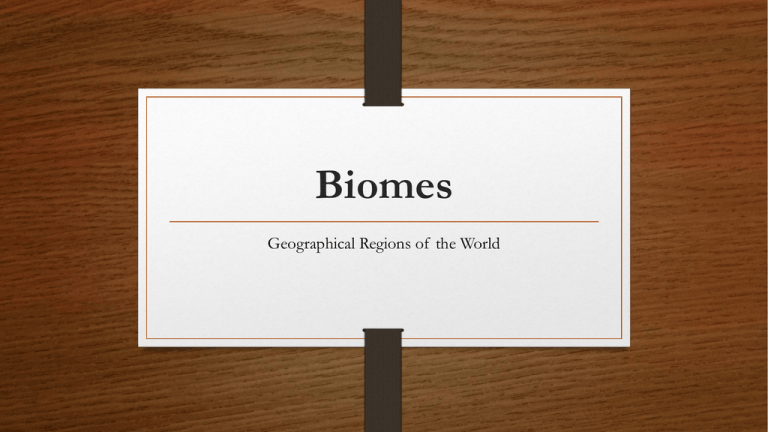Biomes
advertisement

Biomes Geographical Regions of the World HOLDRIDGE LIFE ZONES Biome Graphs WHITAKER BIOME DIAGRAM What are BIOMES exactly? • Biomes are large terrestrial regions characterized by similar climate, soil, plants, and animals, regardless of where they are found in the world. • They are a vital part of the earth’s natural capital. • Differences in average annual precipitation and temperature lead to the formation of tropical, temperate, and cold deserts, grasslands, and forests, and largely determine their locations. • Differences in elevation also contribute to biome locations There are 8 distinct Biomes • • • • • • • • DESERT GRASSLAND SAVANNA CHAPPARAL RAIN FOREST TEMPERATE FOREST CONIFEROUS FOREST (TAIGA) TUNDRA DESERT There are 3 types of desert • Tropical Deserts – examples: Sahara and Namib (Africa) hot, dry, few plants, hard wind blown surface strewn with rocks, sand, large dust storms • Temperate Deserts – examples: Mojave (United States) more precipitation than tropical deserts, sparse vegetation mostly succulents and cacti, high daytime temps in summer, low daytime temps in winter • Cold Deserts – examples: Gobi (Mongolia) Winters are cold, summers are hot, precipitation is low Deserts have low annual precipitation. Plants and animals have adaptations to help them survive the heat and obtain enough water to survive. Ecosystems here are fragile due to the soils taking decades to hundreds of years to develop, which means slow plant growth, low species diversity, slow nutrient cycling, and lack of water. Off-road vehicles are the major environmental threat to these biomes. Climate Graph Mojave Desert Grasslands There are 3 types of grassland • Tropical grassland – examples: Savannas (East Africa) scattered clumps of trees, thorny plants, herds of herbivores, warm temperatures, dry and wet seasons • Temperate grassland – examples: Tall and Short grass prairies (United States, Canada) cold winters, hot and dry summers, sparse and uneven precipitation, fertile soils, grasses have long roots • Cold grassland – examples: Artic Tundra (Alaska, Russia) south of the artic polar ice caps, treeless, covered by ice and snow, permafrost, winters long and dark, short growing season Grasslands tend to be very windy which means that evaporation is rapid. They are also susceptible to fires which helps keep trees from taking over. The tundra is susceptible to permafrost melting, which provides breeding grounds for insects making it ideal for migratory birds. Development and erosion are the major environmental threats to these biomes. Climate Graph Arctic Tundra CHAPARRAL • Chaparral is a temperate shrubland, found along the coasts of southern California, the Mediterranean Sea, central Chile, southern Australia, and southwestern South Africa. • Consists of dense growths of low lying evergreen shrubs, occasional small trees with leathery leaves, thin and not very fertile soils, warm and dry summers, mild wet winters, large populations of humans due to the ideal climate. Mudslides and fires are the major environmental threats to this biome. Forest There are 3 types of forest • Tropical Rain Forest – examples: Amazon, Congo Basin (S. America, Africa) tons of biodiversity, nutrient poor soils due to maximum growing conditions year round, large trees make huge canopies that block out sunlight to lower levels, warm, wet, lots of rainfall daily, decomposition is rapid • Temperate Deciduous Forest – examples: Appalachian Mountains (U.S.) Long warm summers, cold but not too severe winters, abundant precipitation, trees shed leaves in winter, nutrient rich soils from leaf litter, decomposition is moderate • Boreal Forest (Taiga) – examples: Yukon (Canada) Winters are long, dry, and extremely cold, summers are short, sunlight varies with seasons, some days long hours of daylight others few hours of day light, low wildlife diversity due to the cold weather, decomposition is very slow Deforestation for development is the major environmental threat to these regions. Mountains play important ecological roles • • • • • Contain majority of world’s forests Habitats for endemic species Sanctuaries for migrating species Regulate earth’s climate Critical role in hydrologic cycle Natural Capital Degradation major human impacts on terrestrial ecosystems • Deserts are impacted by large desert cities, soil destruction by off-road vehicles, soil salinization from irrigation, depletion of groundwater, and land disturbance and pollution from mineral extraction. • Grasslands are impacted by conversion to cropland, release of CO2 to atmosphere from burning grassland, overgrazing by livestock, and oil production and off-road vehicles in the artic tundra. • Forests are impacted by clearing for agriculture, livestock grazing, timber, and urban development, conversion of diverse forests to tree plantations, damage from off-road vehicles, and pollution of forest streams. • Mountains are impacted by agriculture, timber extraction, mineral extraction, hydroelectric dams and reservoirs, increasing tourism, urban air pollution, increased ultraviolet radiation from the ozone depletion, and soil damage from off-road vehicles.






